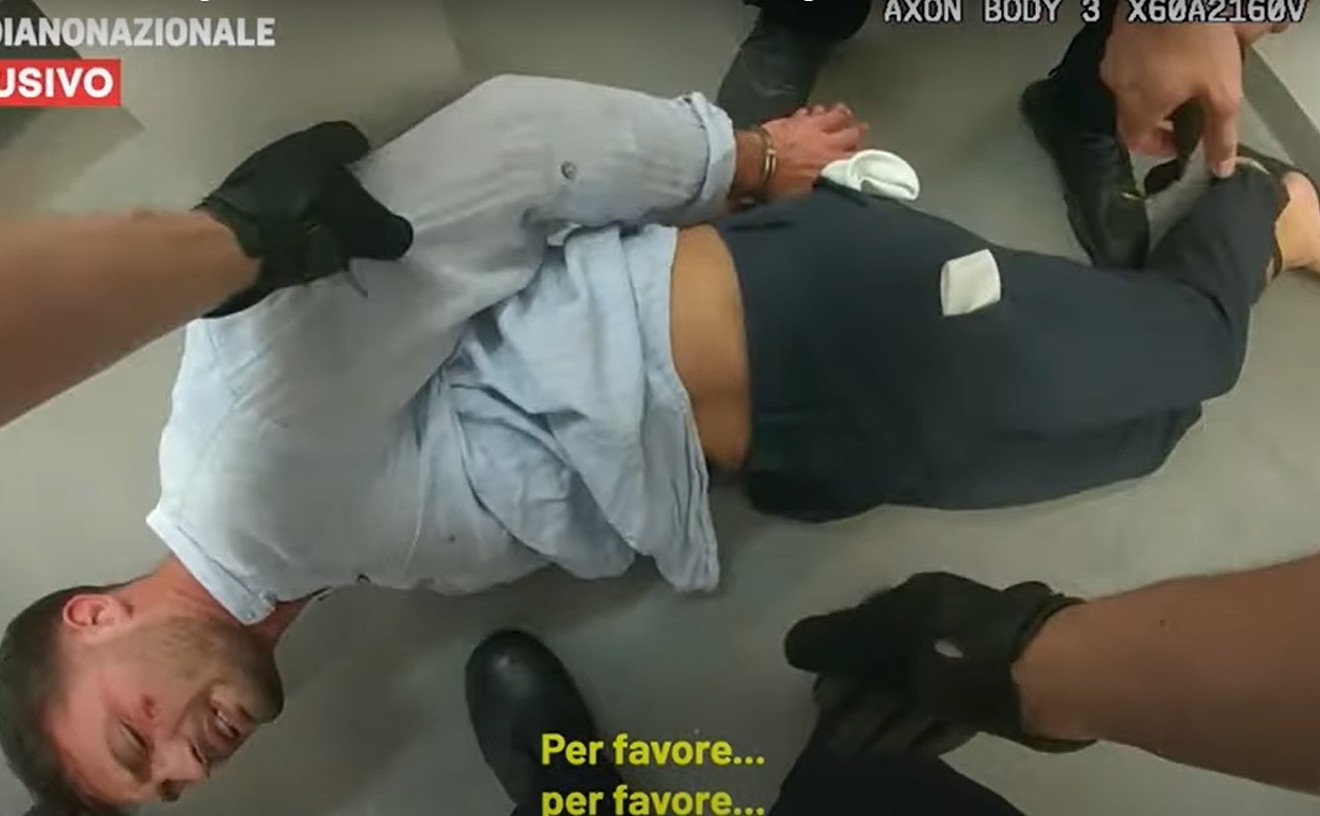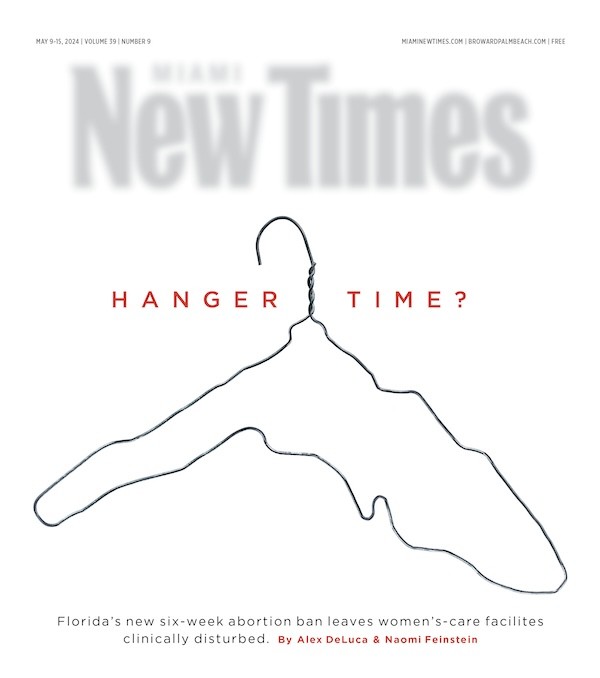At the moment, holding court inside the Miami Beach Cinematheque following its Miami Gay and Lesbian Film Festival presentation of the Fifties camp classic Written on the Wind, Novak is cutting a figure that's far from demure. With a freshly popped bottle of champagne in one hand, she uses the other to mash a palmful of cheese and crackers into her mouth. Crumbs exploding forth, she growls and giddily tips her bewigged head back to keep the entire congealing mess from spilling down onto her black frock. A skilled gender illusionist? More like a transsexual Cookie Monster, and an ornery one at that.
Kulchur turns back to Desi, struck speechless. "Like I said," Desi continues, still deadpan as he nods approvingly, "that boy was born to wear a formal gown."
Given that the 38-year-old Novak's birth name was the equally striking Thomas Strangie, he would seem preordained to a larger-than-life persona -- and certainly one a bit more colorful than would have been possible on the chilly Brahmin streets of his native Boston. So like several other twentysomethings who had gravitated around Desi, united by a love for John Waters and a taste for the ridiculous, Novak moved to South Beach in 1992, helping to usher in a period of nightlife that has since achieved mythological status.
These days it's hard to strike up a discussion of the Beach's current social scene without hearing one of clubland's veterans breathe a tender sigh over the early Nineties, a Wild West period in the city's evolution. Spurred by cheap rent and a libertine vibe, a host of self-professed freaks fashioned a milieu in which gays and straights freely mixed on the dance floor, and an outrageous sense of style was as much the coin of the realm as today's currency of youthful beauty. Moreover political and business notables often could not be outdone when it came to public brazenness: Beach Mayor Alex Daoud left for prison in 1993 after pleading guilty to taking bribes, while developer Thomas Kramer's new South Pointe high-rises were matched in height only by his trash talking and civic brawling.
But there's a conveniently self-perpetuating quality to this kind of nostalgia. With a clutch of that era's nightlife mavens now ensconced in positions as tastemakers at the Herald, Ocean Drive, the most prominent local PR firms, and even at city hall as liaisons to the entertainment and tourism industries, today's clubbers for years to come will be laboring under comparisons to the "good old days." It's a one-sided debate that relies mainly on memories; beyond contemporaneous chronicles such as the sadly defunct Antenna weekly or Tom Austin's "Swelter" column here in the New Times (fortunately achived at our Website), there's been precious little documentation of that period.
All of which makes "The Lost & Found Years," Desi's new photographic exhibit at the Cinematheque, so exciting. It offers up visual proof that perhaps it all really was that fabulous. Shot predominantly in 1994, Desi's pictures focus on the legion of offbeat drag queens who defined nightlife at the time, jostling for attention with the visiting Hollywood stars, New York hipsters, European playboys, and Eastern bloc runway walkers who were all putting South Beach on the international map.
"These are not paparazzi shots," Desi insists. Instead his oversize portraits are the result of begging and wheedling the leading lights of drag to sashay over to his studio -- better known as the roof of his $450-a-month Pennsylvania Avenue apartment, now on the market as a $250,000 condo. "I took these photos to immortalize their lives and capture their inner spirit," he explains. "I didn't realize that I was also capturing a particular time, when they were putting themselves on the line to take command of the city's culture." And that redefinition? "It wasn't trying to mimic straight culture; it wasn't aspiring to traditional beauty. It was aggressive, edgy, and often downright ugly. But with the glut of models and celebrities who were saturating the media then, it was the only way to get your voice heard."
Of course even if they weren't shrieking fiercely above the DJ's beats, it would've been hard to miss the cartoonlike visages of Taffy Lynn, Marvy 70, Bridgit Buttercup, Mother Kibble, Novak, and the raccoon-eyed Damien Divine.
"People used to say to Damien: 'Did you put your makeup on in the back of a speeding cab?'" Novak recalls, laughing. "Well, yes, she did! That was the whole point. We were people who did not fit in -- losers and outcasts with no real family or friends." Which led to some strong bonds being forged over a borrowed tube of lipstick. "We were like organized crime the way we banded together," Novak adds. "We were like a street gang with wigs! The only rivalries were onstage."
To that end, Novak managed to chart new territory by lip-syncing to Madonna's anti-abortion "Papa Don't Preach" with a then-pregnant Madonna sitting in the front row of the audience. At a key moment, the faux-pregnant Novak punctured a water-filled condom under her own belly-engorged dress. Though the real Madonna declined to join in the howls and applause, "I believe I'm the first drag queen to have her water break onstage," Novak enthuses proudly.
For Desi, now a successful salon owner in Boston, looking back on the Beach's drag queens and their progression from provocateurs to props is a bittersweet affair. Surveying his images hung on the Cinematheque's walls, he's at a loss for many of his subjects' whereabouts: "Some are rich, some are dead, and some are just missing." He's also unsure of that scene's precise cause of death, whether it was killed off by soaring real-estate values or the natural life expectancy of any underground movement -- though his shot of Taffy Lynn, snarling for the camera as she holds up a dime bag of cocaine, provides a further clue. "It was a great party, but you knew it had to end," Desi muses. "You can't keep that momentum up."
Novak, however, isn't ready for her curtain call just yet, even if she is one of the last of her original troupe still slipping into high heels. "As long as people will have me, I'll still perform. I'm a ham -- a big, needy ham," she admits with a laugh. "Thank God that when I put the drag on at 22, I did it as an old lady. I never knew I'd grow into the part. I've become the elder stateswoman of drag, the Madeleine Albright of transvestites. "
"The Lost & Found Years" is on display until May 10 at the Miami Beach Cinematheque, 512 Española Way; 305-673-4567.










